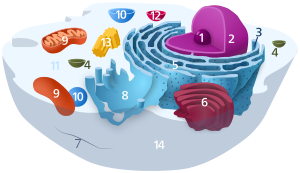
Back Citoplasma AN سيتوبلازم Arabic صيطوپلازم ARY Citoplasma AST Sitoplazma Azerbaijani Цытаплазма Byelorussian Цитоплазма Bulgarian সাইটোপ্লাজম Bengali/Bangla Citoplazma BS Citoplasma Catalan
| Cell biology | |
|---|---|
| Animal cell diagram | |
 Components of a typical animal cell:
|
The cytoplasm describes all the material within a eukaryotic or prokaryotic cell, enclosed by the cell membrane, except for the organelles.[1] The material inside the nucleus of a eukaryotic cell and contained within the nuclear membrane is termed the nucleoplasm. The main components of the cytoplasm are the cytosol (a gel-like substance), the cell's internal sub-structures, and various cytoplasmic inclusions. In eukaryotes the cytoplasm also includes the nucleus, and other membrane-bound organelles.The cytoplasm is about 80% water and is usually colorless.[2]
The submicroscopic ground cell substance, or cytoplasmic matrix, that remains after the exclusion of the cell organelles and particles is groundplasm. It is the hyaloplasm of light microscopy, a highly complex, polyphasic system in which all resolvable cytoplasmic elements are suspended, including the larger organelles such as the ribosomes, mitochondria, plant plastids, lipid droplets, and vacuoles.
Many cellular activities take place within the cytoplasm, such as many metabolic pathways, including glycolysis, photosynthesis, and processes such as cell division. The concentrated inner area is called the endoplasm and the outer layer is called the cell cortex, or ectoplasm.
Movement of calcium ions in and out of the cytoplasm is a signaling activity for metabolic processes.[3]
In plants, movement of the cytoplasm around vacuoles is known as cytoplasmic streaming.
- ^ "4.2: Prokaryotic Cells". Biology LibreTexts. 2 November 2015.
- ^ Shepherd VA (2006). The cytomatrix as a cooperative system of macromolecular and water networks. Current Topics in Developmental Biology. Vol. 75. pp. 171–223. doi:10.1016/S0070-2153(06)75006-2. ISBN 9780121531751. PMID 16984813.
- ^ Hogan CM (2010). "Calcium". In Jorgensen A, Cleveland C (eds.). Encyclopedia of Earth. National Council for Science and the Environment. Archived from the original on 12 June 2012.